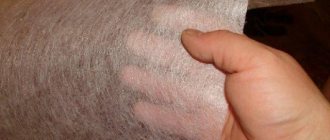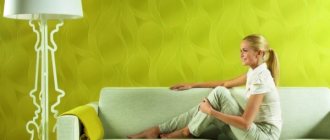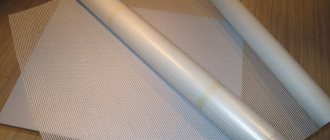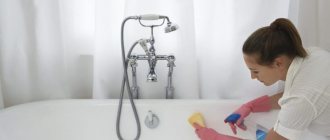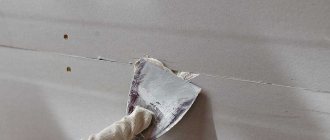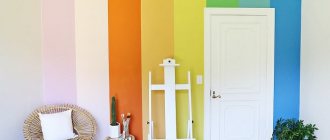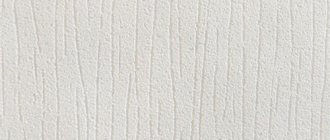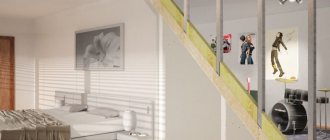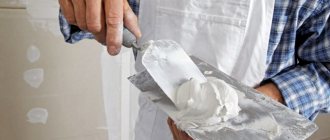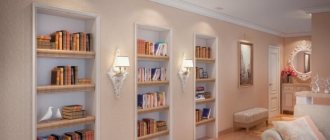Working with wallpaper
Wallpaper is produced in several categories based on the material of production:
Working with non-woven and glass wallpaper gives a double effect:
- A perfectly smooth wall surface; when painted, defects from the wall surface do not appear on it.
- The walls receive a protective and reinforcing coating, guaranteeing cracks or breaks in the future.
Advice. This is especially important in high-rise apartments, where the seams between the walls are constantly growing. They are simply not visible under the glass wallpaper. Working with glass wallpaper has similar characteristics.
Putty on fiberglass - how to cope with the job even without experience
Such types of work as gluing fiberglass and puttying on it are inextricably linked, and if I have already discussed the first part of the process in one of the previous reviews, then the finishing process needs to be analyzed separately. This work is not very difficult if you know all the nuances of the technology and follow all the recommendations that will be presented in the review. We will also figure out how to select high-quality materials so that the result is as reliable as possible.
In the photo: the surface of the fiberglass is not very smooth, and the seams on it are visible, so it is better to putty it
Fiberglass wallpaper is a woven fabric made of glass fibers
Threads are drawn from liquid glass and woven into cloth.
There are two types of glass wallpaper:
The difference between them is only in technology and type of weaving:
- In the first case, the material is similar to ordinary smooth canvas,
- In the second, they are decorated with a certain relief pattern, moreover, they are characterized by greater density than the first.
- Fiberglass is used to strengthen walls and smooth their surfaces.
Note. This procedure is especially often performed in the finishing of ceilings. Here it is easier to glue fiberglass onto its surface than to carry out plastering and putty work.
- The surfaces are perfectly smooth, with a texture reminiscent of marble.
- But they can only look like this if they are painted, and not covered with other wallpaper.
Work procedure
To avoid errors during work and to avoid starting it again, it is important to follow all technical rules.
This is not a very simple procedure, but you can do it yourself.
Preliminary work
The preliminary stage takes place in the following algorithm:
Installation work
The technology for gluing cobwebs will be described below:
Fiberglass is cut inside and outside the corners. In these places the material will tear anyway, but if it is not cut, it will tear unevenly.
Another thing you need to know is that the joint between two sheets should not be done at the joints of drywall. If this is not observed, the web will burst.
It is important to remember where the joints of the drywall and the seams of the fiberglass are, so that they cannot be joined.
The coating dries in about a day. During this period, you cannot ventilate the room; all drafts must be excluded.
After drying, surface finishing can be done further.
Fiberglass has an outer and inner side. If you have experience working with such material, then the sides can be immediately distinguished from each other. But, if this cannot be done, then all this information must be indicated on the packaging. Usually the roll is rolled so that the wrong side is inside the roll.
Puttying
It is necessary to putty the surface because:
Putty on fiberglass is carried out according to the following algorithm:
To make the entire overall structure stronger, it is definitely necessary to use fiberglass. You can’t skip the puttying stage either.
This procedure is no different from putting putty on any other surface.
Source
Advantages of glass wallpaper, comparison with non-woven wallpaper
The material is sold in rolls and consists of fiberglass impregnated with a special substance and a backing.
The front side has a clearly defined texture and is intended for further coloring:
- Non-woven wallpaper is considered a good competitor for them in terms of painting.
- A composite paper-like type of finishing material consisting of cellulose and binder in proportions of 70% and 30%, respectively.
Note. Unlike the material in question, the material is pressed rather than woven. Available in the form of non-woven fabric.
Advantages and disadvantages of both types of paintings:
| Glass wallpaper | Non-woven fabric |
| Eco-friendly, completely harmless to humans. | High degree of strength. |
| Resistant to temperature changes, waterproof. | Abrasion resistance. |
| They allow steam and air to pass through. | Fire resistant. |
| Resistant to aggressive detergents. | The adhesive composition is applied to the base of the wall, and not to the canvas. |
| The degree of strength and durability is high. | Does not shrink after drying. |
| Electrostatic | Having a dense base, they hide minor imperfections on the walls or ceiling |
| Easy to care for. | Lets air through. |
| They can be painted multiple times without losing their appearance. | They are washed with special means and belong to the category of washing coatings. |
| Fire resistant because they do not support combustion. | They don't fade, they stick easily. |
Disadvantages of fiberglass and non-woven wallpaper:
| Glass wallpaper | Non-woven |
| High price of material | When using a fabric with a very voluminous texture, dust collects on it. Remove with a vacuum cleaner or dry cloth; do not get them wet. |
| The adhesive composition used is only that intended for liquid wallpaper. | Low resistance to repeated mechanical damage |
| To dismantle the coating you will need a special liquid | The price of the paintings is very high |
Interesting fact! Non-woven wallpaper, in general, is less durable, more susceptible to abrasion, and is less resistant to accidental mechanical damage, unlike glass wallpaper. For this reason, they are not recommended for use in public spaces.
Non-woven fabrics are considered heavy, and they are prone to moisture absorption. For example, due to normal wetness or glue, so the composition cannot be applied to the canvas. The answer to the question: whether to choose non-woven or glass wallpaper is individual for everyone and depends on one’s own preferences and wishes.
Paint selection
Fiberglass can be painted with materials that are suitable for glass wallpaper. Water-based paints are best suited for this purpose; they do not affect the performance of the base material. Such paints do not have an unpleasant odor and are harmless to humans. Contains only environmentally friendly components (polymers, water, targeted additives). There are several types of water-based paints, they are described below.
Acrylic paints
These paints are the most popular, they have many advantages. Easy application and quick drying, coupled with a low price, are the main advantages. Paints can be applied to fiberglass or wallpaper, the coating will be resistant to friction and water. The materials adhere well to the surface and give a beautiful decorative look. Most brands of paint are sold in white; they can be tinted in absolutely any shade.
Latex paints
Such materials have a higher cost. These are water-dispersion-based enamels, without chemicals, harmless and suitable even for children's rooms. The composition contains natural latex, which makes the coating more resistant to water.
Surfaces with latex paints can be periodically washed or wiped with a damp cloth. This material is very economical and allows you to get long-lasting results. If acrylic materials give a matte film, then latex materials give a matte, semi-gloss, glossy film.
Silicone paints
Enamels containing silicone do not get dirty, this is their important advantage. There are no aggressive chemical components here either, so the material is completely safe. Silicone paints can last up to 25 years without losing their external gloss, but their cost is the highest among water-dispersion compositions. The material is waterproof, vapor-permeable, heat-resistant, and not susceptible to mold, mildew, or ultraviolet radiation.
Where are glass fibers used?
In addition to direct use (as wallpaper), they can be used for:
- Decoration of facade parts.
- Furniture.
- Doors.
- And other surfaces.
The material is not only good and beautiful in terms of finishing, but is also very famous for its practicality:
- It is not afraid of frequent wet cleaning, even with disinfectants in public buildings, in particular hospitals.
- In private houses and apartments, this material is also popular and not only for finishing the surfaces of walls or ceilings, in bathrooms they can replace ceramic tiles (see: Ceramic tiling of a bathroom: a classic of the genre).
- Thanks to its unique properties and texture of the canvas, glass wallpaper gives an appearance unique in style and beauty.
The only condition is the correct selection of colors and tones. The correct gluing instructions and finishing options are presented in the video in this article.
Fiberglass: coating features
Fiberglass wallpaper is a decorative covering that feels like thick fabric. The basis of the material is a special type of fiber (analogue of fiberglass), but they are not only used to make pressed fabric, but also form decorative weaving of various types. This is both a reinforcing and decorative material that will last for several decades, and the paint can be renewed 6-7 times.
The stores offer glass wallpaper of various thicknesses and textures: from primitive zigzags and stripes to floral ornaments and complex patterns. You can apply this wallpaper to any surface: cleaned brickwork, metal, wood, concrete, plastic, chipboard, drywall.
What adhesive to use for gluing fiberglass?
If we consider the composition of the glue specifically for this category of wallpaper, then it is made on the basis of starch, with various additives that improve the moisture-resistant qualities of the canvases and antibacterial properties.
Let's look at which adhesive is best for glass wallpaper, and what it comes in:
- In fact, the more expensive the composition, the faster it swells and has better adhesive properties.
- And since glass fibers are much heavier than their paper counterparts, the choice should be made in favor of those that can better hold them on the surface.
Advice. It is better to choose types based on PVA glue or dispersion, they are designed for heavy canvases.
| 1. | Dry mixes. | Most of the adhesive compositions for this material are produced in powder form from adhesive components with antiseptic additives. It has a low specific gravity and is stored for a long time without losing its qualities. |
| 2. | Ready-made adhesive solutions. | This is a completely ready-to-use composition consisting of adhesives and various additives. It goes on sale packaged in containers (plastic buckets) of 5 kg and 10 kg. Shelf life depends on the manufacturer; it can withstand about 5 cycles (freezing/thawing) without losing its quality properties. |
Workflow Description
We will look at several aspects, each of which is important in its own way, just read all the information so that you have a complete picture of the work ahead in your head.
Necessary materials
First we need to collect a whole list of materials that we will use. Below is a table that lists specific types of mixtures; I use them myself, so I can vouch for the quality and reliability.
Of course, there may be other options, the main thing is that they are of high quality, since even perfect adherence to technology will not allow you to do the job efficiently if you used low-quality components.
All formulations are of high quality and ease of use.
| Material | Description |
| putty | I use Vetonit compounds, as they apply just perfectly and rub off very easily. This type of dry mixes is ideal for beginning craftsmen; there are several composition options for different rooms; you must choose what is best suited for your conditions. As for the cost, the price is 400-450 rubles per bag weighing 25 kg |
| Primer | Where would we be without soil, because it is an indispensable attribute of any finishing work. The amount of composition depends on the chosen technology; below I will talk about the main aspects. The fact is that the composition can be applied once or twice, hence the required volume of primer also changes |
The soil allows you to strengthen the surface
I would like to mention another putty composition - “Shitrok”, it is sold in buckets in finished form, which increases the ease of use. I don’t recommend it only because of its high cost - a bucket weighing 28 kg will cost you about 1,200 rubles, but if costs are not important to you, take this option, as it is easier to use due to the fact that it does not need to be prepared before application.
"Shitrok" is another option that is popular among finishers
Work tool
In order for us to carry out work quickly and with maximum quality, we need to have a convenient and reliable tool at hand:
Fiberglass putty is done using these devices
The mixer can also be rented
A grater is needed for final leveling of the putty layer.
Protective equipment allows you to protect yourself from dust
The working process
Many developers do not know whether fiberglass needs to be puttied before painting, everything is simple: if you do not finish the surface, then the texture of the fibers will appear on it, and the seams will also be noticeable, even if they are joined perfectly and there are no unevennesses. Even if you glue wallpaper, you need to putty on the fiberglass, otherwise later, when tearing the material off the walls, you can separate the cobwebs, which is extremely undesirable.
I hope you have figured out how to glue fiberglass to putty or drywall, and your surface is perfectly flat, otherwise the work will become more complicated, because you will have to create a plane, and not just distribute the composition over the surface.
Now let's look at how to putty a surface; instructions for doing the work yourself are as follows:
The workflow consists of these actions
Masking tape will prevent any damage to the adjacent finish.
Mix the ingredients thoroughly
“Vetonit” in its finished form retains plasticity for a day, and if it is stored in a closed container, then for two, so there is no need to prepare the mass, like gypsum-based options, in small portions. Calculate how much you will have time to apply in one approach, and prepare as much solution as you need, this is very convenient.
Work begins from the abutment, the composition is stretched in a thin layer
Directional light reveals all surface irregularities
The primer strengthens the surface
The difference between fiberglass and glass wallpaper
Fiberglass, otherwise known as painter's web, is a building material created from natural ingredients, sand and natural resins. Fiberglass is produced by heating special glass and then drawing fibers from the glass, which are arranged in a chaotic manner, dried and the finished material is obtained. The manufacturing process is similar to the production of fiberglass wallpaper, however, there are significant differences in the production and use of finishing materials. The differences between fiberglass and glass wallpaper include:
- Creating glass wallpaper is weaving from heated glass fibers; the arrangement of threads in the fiberglass is chaotic, without patterns or designs. Fiberglass is produced by pressing, which reduces time costs.
- Fiberglass is a relief decorative finishing material, fiberglass is an element of the final or intermediate finishing of a wall or ceiling in order to strengthen the surface. Fiberglass is absolutely smooth, which allows it to be used as a preliminary preparation of the surface for further finishing.
Application areas of canvas
This material is indispensable for finishing work and for the production of building materials. He takes part in the production of:
- aqua panels;
- waterproofing;
- linoleum;
- foam glass;
- printed circuit boards;
- roll roofing;
- glass wool in slabs;
- elements of drainage systems.
- prepare surfaces for wallpaper, painting, drywall, various panels;
- They make waterproofing and anti-corrosion protection of pipelines, combining it with mastics or bitumen.
Using a painting web:
Fiberglass is used as a reinforcing layer, which protects the finishing coating from cracks, shedding and other similar defects. The reverse, fleecy side is almost always on the outside of the roll. The facial one, on the contrary, is ideally smooth; it is often “hidden” inside it.
Advantages of using fiberglass
The use of fiberglass is justified in many cases of construction or repair:
- Shrinkage of a newly constructed building. In this case, glue the fiberglass to the walls and ceiling, and the problem of cracks will not be a problem for the new renovation.
- Expansion and contraction of structural materials due to temperature. Fiberglass will extend the service life of the material for a long time.
- Roofing. Place fiberglass directly under the bitumen impregnation to strengthen the surface.
- Strengthening the walls of the room in which equipment with increased vibration is located during operation. Or the location of the house in close proximity to the railway.
- An additional layer when laying waterproofing and creating a drainage system in a summer cottage.
The advantages of fiberglass include:
- Environmentally friendly and natural composition, the use of fiberglass is allowed in any premises, medical institutions, apartments with children, allergy sufferers and animals.
- Safety, the material is not flammable and does not corrode.
- Antistatic, does not attract dust, debris, does not create static.
- Air permeability, thanks to the breathing properties of the base, the appearance of mold and fungi is not dangerous.
- Easy to maintain if fiberglass is chosen as the final finish. It won't take much time to quickly brush off the dust or wash the stained area.
- Durability, fiberglass will last longer than 30 years.
Types of fiberglass
The material varies in density per 1 sq.m.; there are 3 main types of fiberglass. Density of fiberglass 25 g/sq.m. means that a square meter of material weighs only 25 grams. The optimal place to use such a fabric is the ceiling; fiberglass of this density is often called ceiling web. The advantage of the low weight of fiberglass is also its disadvantage - before use it is necessary to get rid of large cracks in the base, if any, on the surface. Cobweb with a density of 40 g/sq.m. – a universal option, used for reinforcing the walls of premises for further painting or wallpapering. This material is also suitable for strengthening the ceiling of old buildings or those located in a high vibration zone.
Fiberglass with a density of over 50 g/sq.m. used in industrial premises with high load on the walls from operating machines and equipment. A larger amount of material is used for production; gluing will require a lot of glue and paint, so this type of finish is not practical for use in residential premises.
How to remove glue from spider webs
Excess adhesive must be cleaned off at the joints with a spatula; its location should create a right angle of 90 degrees. Excess glue on the surface can be removed by simply wiping it with a clean cloth. Work is performed in a respirator, protective clothing and gloves.
Excess glue on the surface can be removed by simply wiping it with a clean cloth.
The article described how to glue fiberglass correctly. This is a simple process that you can handle on your own. The main thing is to choose a suitable adhesive solution.
What is better to choose for painting: glass wallpaper or paper wallpaper
10/14/2018 Painting walls is one of the most effective and simple methods of interior decoration. Modern paints allow you to give the room an aesthetic appearance, make it rich and beautiful. Painted walls, unlike wallpaper, look monolithic and have no seams. Finished surfaces are easy to clean, do not absorb odors, provide a long service life and allow you to update the interior with a simple repainting.
Before carrying out this kind of repair, the walls must be prepared. If the old plaster is weak, or there are significant defects on the surface in the form of broken areas or large irregularities, then preliminary plastering is indispensable. But when it comes to relatively smooth walls or ceilings with minor defects, you can get by with less labor-intensive preparation. For this purpose, special types of rolled covering materials are used: glass wallpaper or paintable wallpaper on a non-woven basis. For many, choosing one material or another can be difficult. Which is better? Let’s try to figure it out in this article.
Fiberglass and its use
Despite the promising name, fiberglass in rolls is not at all as strong as glass; if handled carelessly, it can even be torn. However, if you glue it using technology, it will become real “armor” and will not allow cracks to spread. Available in rolls (width 1 m, length up to 50 meters), the density varies from 25 to 65 grams per square meter, but even the minimum density is enough for finishing the ceiling and walls.
The composition of fiberglass includes quartz sand, soda, dolomite, lime and chemical additives. The mixture heats up, forming threads that stick together and become like a spider's web.
Is it necessary to use fiberglass under the putty mixture?
Most renovation specialists are faced with the problem of cracks along the joints on drywall surfaces.
Even a special mesh cannot always prevent the appearance of cracks, because they appear under the strong influence of shrinkage of the house or temperature changes.
To prevent this from happening, you can use fiberglass (in ordinary speech it is called cobweb), it is actually fiberglass. But this is not like glass wallpaper (braided threads), but a pressed material. With its help, you can strengthen the base well and prevent cracks from appearing.
To improve the technical performance of this material, it is recommended to apply a layer of putty on it.
This article will tell you how to use fiberglass and how to properly prepare it for coating with putty mixture.
How does fiberglass differ from glass wallpaper?
- Preparation method. Fiberglass is compressed threads; its texture resembles a sheet of paper with randomly located “cobwebs”. Glass fiber wallpaper is more complex: glass fibers are woven into beautiful fabrics on a loom;
- Drawing. There is no pattern on fiberglass, it can be painted many times. Various patterns are applied to the surface of the wallpaper, but the number of repaintings is limited to 6-7 repetitions;
- Function. Wallpaper is a decorative and at the same time reinforcing coating, while fiberglass only smoothes the surface. We would like to point out that before painting, glass wallpaper is sometimes primed with diluted glue and nothing else, but a primer must be applied to fiberglass;
- Pasting. Glass wallpaper with a pattern must be glued onto the surface end-to-end, the pattern adjusted, but fiberglass, if you need to cut out small sheets, can be glued overlapping;
- Density. Fiberglass has a density of 26-65 g/sq.m, for glass wallpaper this figure is higher - from 150 to 225 g/sq.m. Accordingly, the weight of glass wallpaper is also greater;
- Price. A web of fiberglass will cost about 3 times less than fiberglass.
Fiberglass is the embodiment of wonderful qualities: strength, beauty, moisture resistance, environmental friendliness, why not try using it in the interior? Moreover, glass wallpaper has proven itself to be excellent over the past decade!
Tips for choosing this material
Fiberglass has a high level of resistance to various negative environmental factors (moisture, fire, chemicals, mechanical stress).
The parameters of such material do not deteriorate for a long time.
The best density of fiberglass should be up to 55 grams per square meter. They sell it in rolls 50 meters wide. It is possible to buy not the entire roll, but only the required quantity.
To stick the material, purchase a special glue, the same as for glass wallpaper.
The adhesive composition should be chosen of good quality, because it affects the overall strength of the entire structure.
The consumption of such a product for fixing fiberglass under putty will be half as much as when working with glass wallpaper.
The high level of adhesive consumption depends on the characteristics of the web - it is completely saturated with glue.
Advantages of non-woven wallpaper for painting
Non-woven wallpaper has a number of undeniable advantages that increase interest in this type of finishing material. Strengths are expressed in the following:
- Pronounced decorativeness. Vinyl-coated wallpaper has a pronounced texture that is not lost even with multi-layer paint application. The material allows you to give the walls a relief pattern, which is clearly visible visually and makes the room more aesthetically pleasing.
- Light weight. Non-woven fabric is a lightweight material, due to which the canvas does not create high loads on the base. And it can be used for reinforcing loose and porous bases, used on walls with a slope, arched passages and ceilings.
- Elasticity and flexibility. Non-woven wallpaper takes the shape of the wall well, and at the same time perfectly masks defects without the possibility of tearing or damaging the canvas, as is the case with glass wallpaper. Non-woven fabric is much easier to glue, reducing the labor intensity of repair work.
- Foundation strength. Non-woven wallpaper, like fiberglass, provides high strength to tensile loads. They perfectly reinforce the wall and prevent the formation of cracks. Recommended for finishing new houses that are shrinking.
- Moisture resistance. Due to the introduction of polyester fibers into the composition, non-woven fabric has pronounced moisture resistance. It does not absorb moisture from the air and does not lose its properties even after short-term contact with water. Finished walls can be cleaned with a damp cloth.
- Vapor permeability. The material allows steam to pass through well. Like fiberglass analogues, they allow walls to “breathe”, provided the paint is chosen correctly.
- Repeated repainting. This type of wallpaper can be repainted up to 5 times. At the same time, the new layer of paint will not deteriorate the decorative effect of the relief.
Disadvantages of non-woven wallpaper for painting
Along with the positive qualities, non-woven wallpaper for painting has its own characteristics and disadvantages. They are expressed as follows:
- Low strength of the decorative layer . Paintable wallpaper with vinyl coating is not wear-resistant. The coating can be easily scratched even with a fingernail. This limits the scope of use of such material. It is not recommended for use in finishing premises with high traffic intensity (offices, administrative and public institutions). If there are animals with claws in the house (especially cats), then it is better to give preference to fiberglass analogues.
- Low chemical resistance . Non-woven fabric does not have any significant resistance to aggressive substances. It can be damaged by alkali and acidic environments. This limits the applications of the products to residential, dry and clean areas.
- Price. Non-woven wallpaper cannot be considered a cheap material. Although, if we take into account that they do not absorb paint as abundantly as fiberglass, repairs using non-woven fabric will be more budget-friendly and less labor-intensive.
Preparation of fiberglass for decorative coatings
Decorative coatings, first of all, should be divided into thick-layer and thin-layer, since the preparation is carried out in completely different ways.
In addition, the process of gluing fiberglass is slightly different: the glue is applied in a thick layer so that when smoothing the fiberglass, it seeps through. This achieves a high load-bearing capacity of fiberglass; the decorative layer under its own weight will not lead to peeling of the fiberglass covering from the wall. Fiberglass for thick-layer decorative coatings , such as “Marseille wax” and other interior structures, does not require special preparation. Only the fiberglass is primed with primer-paints filled with quartz sand, possibly diluted with water in the proportion specified by the manufacturer. For application, use a brush or roller with medium bristles. If the fiberglass was glued in the “folk” way, that is, with putty, then before applying primer-paint it is treated with a fine-grained acrylic primer of deep penetration. Do I need to putty on a plasterboard ceiling before painting?
You can read about this method in the “painting work” section, article about materials for preventing cracks.
Fiberglass canvas for thin-layer decorative plasters and paints is prepared in such a way as to remove its relief structure. To do this, fiberglass is prepared for putty, then puttied with finishing acrylic painting compounds (as practice has shown, they have better adhesion and minimal shrinkage). If it was glued to putty, then it is primed with acrylic impregnations, otherwise no preparation is made. In order to putty fiberglass with high quality, you need to try to complete the work in one thin layer, not exceeding 2 mm in thickness.
Then everything follows standard technology: sanding the dried layer and priming.
What is non-woven wallpaper for painting?
Non-woven wallpaper for painting is a rolled finishing material, the production of which is based on the use of non-woven fibers.
Non-woven fabric itself is a semi-synthetic material obtained from a mixture of natural cellulose and an artificial polymer - polyester. Thanks to this, the product has excellent strength. It is prone to elastic deformation and can take any shape without loss of properties.
Non-woven wallpaper for painting is produced in different densities and with different decorative properties. This allows you to choose the optimal brand for different conditions. Basically, this material is divided into two subtypes:
- Painting non-woven fabric;
- Paintable wallpaper with a non-woven base.
Painting non-woven fabric is a thin fabric made from 100% pure non-woven fibers. Often this is a chaotic interweaving of threads, which in everyday life is called “cobweb”. Such products are excellent for finishing smooth walls and ceilings. After painting, a smooth layer without a relief texture is formed.
Paintable wallpaper with a non-woven base is similar to ordinary vinyl wallpaper. As a lining (main) layer in such products, a thick non-woven fabric is used, on which a decorative layer of foamed vinyl is applied. To produce this type of wallpaper, all kinds of stencils are used. Thanks to this, the choice of decorative patterns is very large, which is important when decorating residential premises.
If you liked the article, please share it
Previously on the topic:
Share
How to choose painting non-woven fabric
Once you are finally convinced of the need to purchase painting non-woven fabric for painting, you need to select it correctly to the parameters of your house or apartment. Non-woven fabric is an environmentally friendly material and is harmless to use. Therefore, make sure that the seller has all the necessary quality certificates and documents necessary for the sale to ensure the authenticity of the goods. Non-woven fabric must not contain PVC. Just like wallpaper, it allows steam to pass through. It shouldn't stretch. Pay attention to its texture: it should be perfectly smooth and soft, like a baby's skin. Particles of foreign origin should not appear on it. The edges should be smooth. The material itself has increased elasticity: make sure of this. Ask the seller more questions about quality. He must know what he is selling. Study the composition carefully: there should not be any chemical elements unknown to you, because you are purchasing an environmentally friendly product. Painting non-woven fabric consists of cellulose. Don’t think that you can’t choose the right material for painting. You have already made the right choice by agreeing to purchase it for renovations in your home.
Step-by-step instruction
After preparing the necessary materials and tools, you can begin roughing the surface. After gluing the fiberglass, 48 hours later you can begin decorative finishing.
Required materials and tools
It is important to prevent glass fiber from coming into contact with mucous membranes and exposed skin. Therefore, stock up on:
Materials you will need:
Required tools:
Primer and removal of surface defects
The preparatory stage involves priming and eliminating minor surface defects. If fiberglass is glued over OSB, then it is necessary to sand off the factory protective coating of the board.
Preparation:
It is recommended to apply the final layer of primer (before pasting) no later than 4 hours before starting work. It is better to sand significant defects if the surface is being prepared for painting. Minor ones will disappear under the canvas.
How to glue cobwebs to drywall or OSB?
Marking the canvas is similar to the method of wallpapering. The roll is stretched on the floor and cut to the height of the wall. The glue is applied to the base, not to the material. Before painting, the strips are glued end to end, and the sticker starts from the corner.
Stages of work:
When attaching fiberglass to the ceiling, the canvas is cut into several fragments. Painting and puttying of the material can be done no earlier than 48 hours later. 3–4 hours before the start of work, it is covered with penetrating soil.
Do not allow the material to join at the seams of plasterboard or OSB - they must be covered with a solid sheet. Otherwise, the putty or paint in these places will crack.
Surface painting
There are 2 ways to paint fiberglass canvas - with and without putty.
In the second case, it will be difficult to achieve a uniform surface, which will significantly increase paint consumption. This option is suitable when it is necessary to preserve the relief of the web and if the joints of the fiberglass are invisible. If this is not necessary, apply 3-4 layers of putty before painting. It is important to sand and prime the plastered surface a maximum of 3–4 hours before starting work. The paint is applied with a short-nap roller in 1–2 layers. For this, water-based, latex or acrylic compositions are used. The second layer is applied 8–12 hours after applying the first. Hard-to-reach places are painted with a soft brush.
Disadvantages of glass wallpaper
It would be completely wrong to talk only about the advantages of glass wallpaper. After all, this material has its own application features and disadvantages that limit the possibility of use in specific conditions. The disadvantages of glass wallpaper include:
- Lack of flexibility. The material does not withstand bending loads well. In particular, if you glue canvases to curved walls with large depressions and defects, the result may be the appearance of cracks and loss of presentability. In view of this, glass wallpaper should be used exclusively on leveled substrates with a small number of defects.
- Porosity. The presence of a porous structure is both an advantage and a disadvantage of glass wallpaper. On the one hand, this property allows the walls to “breathe”, but on the other hand, it increases paint consumption. The applied paint penetrates well into the porous structure, due to which the first painting requires the use of copious amounts of paint and varnish. This, in turn, results in additional budget expenditure.
- Heavy weight. Fiberglass wallpaper itself is heavy, which can negatively affect the quality of use. The mass of the material is also increased by a layer of paint and glue used to fix the paintings on the walls. Together they create a large load on the base. For this reason, glass wallpaper is not suitable for loose substrates, inclined surfaces and ceilings. For the same reason, it is not recommended to repaint glass wallpaper many times.
- Difficult to dismantle. After gluing and drying the glue, sometimes you have to tear off the glass wallpaper, as they say “alive” - along with the plaster.
- Loss of decorative effect when re-painted. Textured glass wallpaper has a slightly pronounced relief. Each subsequent painting will lead to a deterioration in the visual effect of the decor.
- High price. Fiberglass wallpaper itself is an expensive product. Along with the need for a large consumption of paint, carrying out repairs with such material can cost a pretty penny.
Recommendations for selection
When choosing a quality adhesive, you need to consider a number of factors. Namely:
- composition, it is desirable that the mixtures do not contain harmful substances, there are environmental adhesives;
- fireproof, moisture-resistant properties are important in conditions when the canvases are glued in the bathroom or kitchen;
- reliability of adhesion, it is important to select compositions taking into account the material of the surface to be coated;
- ease of use, it is better to take mixtures that are easy to prepare, apply evenly to the walls, and do not flow.
There are many manufacturers that produce products that meet all of these requirements. It remains to give preference to one of them.
